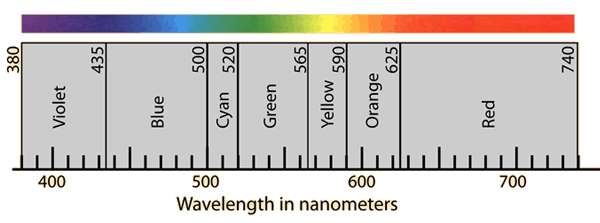Spectral Colors

In a rainbow or the separation of colors by a prism we see the continuous range of spectral colors (the visible spectrum). A spectral color is composed of a single wavelength and can be correlated with wavelength as shown in the chart below (a general guide and not a precise statement about color). It is safe enough to say that monochromatic light like the helium-neon laser is red (632 nm) or that the 3-2 transition from the hydrogen spectrum is red (656 nm) because they fall in the appropriate wavelength range. But most colored objects give off a range of wavelengths and the characterization of color is much more than the statement of wavelength. Perceived colors can be mapped on a chromaticity diagram.

Please note that the above is a very qualitative depiction of the colors associated with different wavelengths of light - it is not a precise colorimetry document.
Vision concepts
Color vision
Visible spectrum
| HyperPhysics***** Light and Vision | R Nave |

